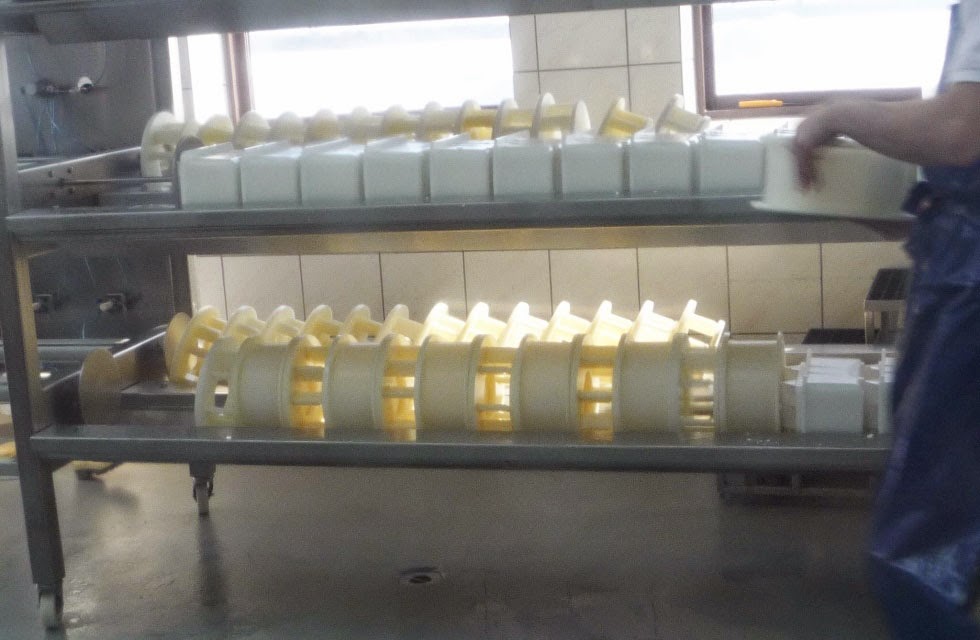A few weeks ago I had the opportunity to visit Fromagerie du Champ à la Meule located
in Notre-Dame-De-Lourdes in Quebec's Lanaudière region. Magali, one of my
co-workers, who happens to be the niece of Martin Guilbault owner of the
Fromagerie, had organised for a few of us from work to visit their premises.
Although it was a very early morning departure from Montreal, it was necessary
for us to arrive early at the fromagerie, to view all the various processes
involved in their cheese-making.
On the day of our visit we had the good fortune of witnessing the
fabrication of three of Fromagerie du
Champ à la Meule's cheeses; Laracam,
a soft washed rind cheese, les Métayères,
a semi-soft washed-rind cheese and Le Joliette
a raclette type cheese.
Fromagerie du Champ à la Meule has recently undergone some major equipment upgrading to facilitate various cheese-making tasks and to allow them to increase the production of their cheeses as they are now selling their products across Canada.
Fresh raw cow milk from neighbouring farms is delivered first
thing in the morning. Then, 3000 litres of milk is pumped into a huge vat where
the milk undergoes thermisation. This process is similar to pasteurisation but
uses lower temperatures allowing the milk to keep more of its original taste.
For thermisation; the milk is heated at temperatures of around 57–65 °C
(145–149 °F) for 15 seconds. For pasteurisation; the milk is heated at 72 °C
(160 °F) for 15 seconds.
Starter culture and milk-clotting enzymes are then added to the milk in order to be able to coagulate the milk to form a more custard-like mass. The cutting process is done in the large vat as it is equipped with blades; this cuts the milk mass into small pieces to begin the process of separating the liquid (whey) from the solid (curds). This cheese-making process solidifies the milk proteins and fat into a solid curd.
Once the desired temperature and firmness of the curd is achieved, the whey is then drained off; leaving a tightly formed curd that is then cut and transferred into their appropriate forms. These forms or cheese molds are designed with holes to allow the whey to drain from the curd.
For the pressed cheeses (Les Métayères & Le Joliette), the cheese molds are aligned on a belt and this allows them to press several molds at once. A light pressing is done at first to allow the remaining whey to escape and then the forms are pressed more severely to solidify the cheese.
The cheese is then left to continue draining overnight and then removed from their forms to be brined by immersing them in a saturated salt solution which will help the rind of the cheese to be formed. The rind’s function is to protect the interior of the cheese and allow it to ripen simultaneously.
The cheese is then left to continue draining overnight and then removed from their forms to be brined by immersing them in a saturated salt solution which will help the rind of the cheese to be formed. The rind’s function is to protect the interior of the cheese and allow it to ripen simultaneously.
The cheese wheels are then left to dry and mature in a controlled
environment where the temperature and humidity play an important part in the
affinage stage. The length of time the cheeses
are aged varies from the different types and will also determine the quality
and flavour of the cheese being produced.
If you are ever in the Lanaudière area, I suggest you stop by to
visit the Fromagerie du Champ à la Meule and stock-up on some great cheese.
Fromagerie du Champ à la Meule
3601 rue Principale,
Notre-Dame-de-Lourdes, Qc J0K1K0
Tel. (450) 753-9217
Read more on Les Métayères
Read more on Victor et Berthold 










No comments:
Post a Comment